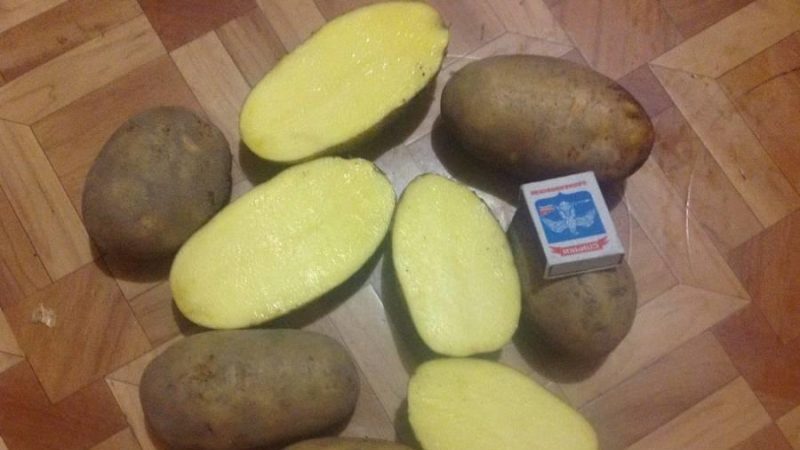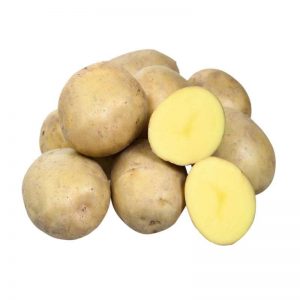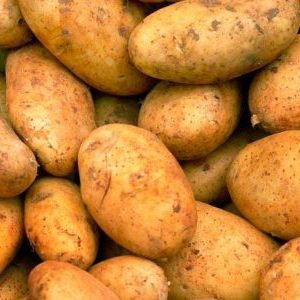Medium early potato variety "Breeze" from Belarusian breeders
Potato Breeze, with proper care, produces a high yield that can feed the entire family, including distant relatives. The variety does not require special efforts and costs for care, it is immune to the most common diseases of the nightshade.
How to properly grow Breeze in the garden to get the most out of it, read our article.
The content of the article
Description of potato variety
The Breeze variety is a selection product with improved qualities. Possessing the main positive characteristics inherent in other varieties of potatoes, it additionally has a high resistance to diseases and pests.

Origin and development
The mid-early potato variety Breeze was developed and patented by Belarusian breeders. Due to the high assessment of economic usefulness, the vegetable was included in the Russian State Register of Protected Breeding Achievements Permitted for Use.
Appearance
The plant is a medium-tall, upright shrub with a relatively thin, faded green stem. The leaf shape is typical of a potato bush, but slightly larger than that of traditional varieties. The surface is laced with dark veins, and the edges look like a slightly wavy line. The entire leaf area has slight waviness and roughness. The leaf plate is colored deep green.
Small flowers attract attention with a reddish white or purple color. The inflorescence looks like a medium-sized corolla.
Potato tubers have a large oval shape. The flesh and skin are yellow. The outer cover is medium smooth. Few eyes are located on the tubers in a spiral. The depth of the eyes reaches a size of 1.1-1.3 mm. The average weight of one tuber is 130 g. The starch content of the fruit corresponds to 12-16%, the dry matter content is 20%.
Attention... The use of mineral fertilizers has a targeted effect on the yield, nutritional and taste qualities of potatoes.
Description and characteristics of the plant and crop
Medium-early variety Breeze for table use is suitable for making chips, french fries, and freezing. When cooked at home and in catering establishments, it demonstrates excellent nutritional and taste properties when boiling, making mashed potatoes and other dishes. The tasting score of the boiled vegetable is 7 points.
Under acceptable conditions, the keeping quality of tubers, that is, the ability to maintain their qualities for 6-12 months, is 97%. The vegetable is resistant to mechanical damage.
Yield
The breeze is able to give 8-12 medium and large tubers from a bush, that is, about 1.5 kg, but practice shows more impressive figures.
In general, the yield of this variety is considered to be quite high and reaches 300 c / ha. First of all, the soil condition affects the yield indicator.

How to grow this variety
A good harvest of Breeze is possible with high-quality germination of tubers and standard care.
Timing, scheme and landing rules
Ideally, planting material is selected in the fall, but this is possible only if there are suitable conditions for storing potatoes - a cool room, protected from severe frosts and high humidity.
The preparatory stage starts approximately 2-4 weeks before planting potatoes... The seed is sorted into high-quality and spoiled tubers. Its processing with a weak solution of potassium permanganate or any other antiseptic is welcomed.
Attention... For planting, choose medium-sized fruits. Large tubers can be cut into several pieces, just make sure that each of them has sprouts.
Then the tubers are germinated within 15-30 days. To do this, containers with potatoes are taken out to a bright, warm place with an air temperature of about 13 ° C. Alternatively, place the tubers in an area protected with plastic wrap.
Special attention is paid to digging and fertilizing the soil. It is advisable to dig up the ground in the fall, and in the spring to loosen and remove the remains of plants, roots, stones. fertilizing with mineral fertilizers will increase the yield.
Potatoes can be planted in late April - early May, when the ground is already warm enough, with a temperature of + 7 ... + 11 ° С. Dig holes 9-10 cm deep or a trench of similar depth. The distance between the pits is left about 40 cm, and between the rows - 70 cm.This scheme will subsequently allow carrying out agrotechnical measures without fear of harming the bushes.
It is better to put more than one tuber in the hole and at the same time add organic matter such as compost, manure or ash. Sprouted eyes should be on top. Sprinkle potatoes with dug soil or mulch.
Attention... Mulch helps to protect the soil from rapid drying out, water washout and weathering. Pine or spruce material, chips or bark, cut grass, etc. are used as mulch.
After planting, potatoes do not need to be watered, because the land has not yet completely dried out after a snowy winter and a wet spring. The southern regions are distinguished by mild weather conditions and little snow in winter. Therefore, watered as needed.
Care
Agrotechnical measures for the medium early variety Breeze are standard.
Regular loosening promotes the supply of oxygen to the soil. The procedure is carried out after watering.
Water the Breeze in moderation, as excess moisture will lead to a lack or complete absence of oxygen. Ideally, they are guided by the condition of the soil. Dry soil requires watering, while slightly damp soil may wait a bit.
Attention. The first watering in regions with a temperate climate is carried out half a month after the appearance of green shoots. The second is during the formation of the bud. The third is after the end of flowering.
Sluggish tops combined with dry soil indicate the need for watering. It is necessary to wet the soil by 30-50 cm. It is better to water in the morning or evening. Watering at lunchtime, especially in the heat, will destroy both tops and tubers.
The first fertilizing with mineral fertilizers is carried out a month after planting. Superphosphates, sulfates, urea show themselves ideally. Substances are introduced under the root in a dissolved state. Excellent results are obtained by the second and third feeding, which are carried out at the same frequency as watering.
Be careful with nitrogen fertilizers - they stimulate the growth of greenery to the detriment of the tubers. Bulky, bright or dark green tops are a sign of an excess of nitrogen.
Weeding is an important part of agricultural activities. Weeds cause irreparable harm to the bushes: they take away moisture and mineral fertilizers from them, thereby reducing soil fertility. In addition, they can shade and oppress planted vegetables. Weeds are removed by weeding or using herbicides.
Hilling is justified in the northern regions. Hilling is not recommended in the south. The procedure is carried out before watering in the morning or evening.
The nuances of growing and possible difficulties, diseases and pests
Some experts recommend cutting the tops two weeks before harvest. They claim that in this way the growth of tubers is accelerated.
Most often, potatoes are affected: scab, late blight, golden nematode, black leg, etc.
For the treatment of plants, fungicidal and antibacterial drugs are used. In some cases, folk remedies are used. For late blight, the following composition is used: 200 g of garlic are added to 10 liters of water and this is poured over the bush. Ammonium sulfate is used as a preventive measure. In addition, diseased bushes are dug up and burned.
Among the pests, the most famous are the Colorado potato beetle, cicada, wireworm, etc. They destroy harmful pests with the help of insecticides ("Tabu", "Decis"), acaricides ("Nissoran"), nematicides ("Nematodos"), rodenticides.
Collection, storage and use of the crop
Breeze potatoes ripen in 100-115 days. Harvested in dry weather. In dry conditions, tubers are easier to clear of adhering soil. In addition, they are sorted by size and degree of damage. Further, antifungal agents are used that increase the life of the fruit and are transferred to a special room.
Advantages and disadvantages of the variety
The positive properties of Breeze include:
- prolonged shelf life;
- presentable appearance;
- high resistance to diseases;
- high productivity;
- the availability of cultivation on almost all types of soils.
There are practically no disadvantages of the Breeze variety. Agrarians note a weak resistance to nematodes and late blight.
Which regions is best suited for
The Central Federal and Northwestern Federal Districts are recognized as regions of zoning.
Farmers reviews
The reviews of ordinary summer residents about Breeze are mostly positive:
Svetlana Ivanovna, Yaroslavl: I grow the Breeze variety because of the qualities: not boil, tasty, well kept. It's easy to look after him: only when the heat is intense I often water and loosen the earth. And the harvest is enough for salads, and for spinning, and you can sell a little ”.
Vera Andreevna, Ryazan: “The breeze in the garden has been growing for three years. I and my family liked this variety. And he looks handsome. We save potatoes from diseases with chemicals, the main thing here is not to overdo it. One or two times a season is usually enough to spray and wait for a good harvest. The husband periodically spuds the ranks. We water it a couple of times a season, or even less, because we have problems with water. "
Read also:
How to breathe correctly over potatoes with sinusitis and is it possible to do it.
An early ripe, frost-resistant potato variety "Rosalind".
Potatoes in the fight against hemorrhoids: how to make candles and compresses.
Conclusion
The mid-early variety Breeze is generally recognized by Russian gardeners and farmers. This is a worthy alternative to the usual varieties grown in the gardens and fields of the country for more than a decade. But be prepared for a bountiful harvest - build a vegetable storage that will ensure the safety of the tubers until the next season.